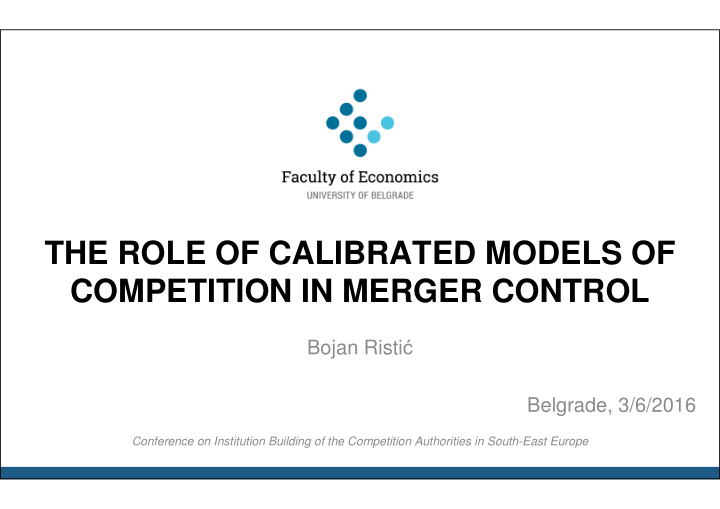



THE ROLE OF CALIBRATED MODELS OF COMPETITION IN MERGER CONTROL Bojan Risti ć Belgrade, 3/6/2016 Conference on Institution Building of the Competition Authorities in South-East Europe
Contents • Introduction • Literature • Rationale for simulations • Basic steps of simulations • The naive example • Conclusions
Introduction • The purpose of unilateral merger effect control – To prevent substantial lessening of competition ( SLC ) – Finding the sign and the magnitude of Δ CS – We need some economic tools… • The role of calibrated models for merger simulations – It is complementary to the traditional tools – It can reduce regulatory mistakes without excess regulatory costs – Calibration vs estimation of used model’s parameters (with enough time and resources we can use both) • The outcome of simulations – Deducing the sign and the magnitude of Δ CS by incorporating lessening of competition and expected efficiencies in the same model
Literature • Farrell, Joseph & Carl Shapiro (1990), “Horizontal Mergers: An Equilibrium Analysis”, The American Economic Review , Vol. 80, No. 1, March, 107-126. • Werden, J. Gregory & Luke M. Froeb (2002), “Calibrated Economic Models Add Focus, Accuracy, and Persuasiveness to Merger Analysis”, Vanderbilt University Law School, Law & Economics Working Paper No 02-22. • Budzinski, Oliver & Isabel Ruhmer (2009), “Merger Simulation in Competition Policy: A Survey”, Journal of Competition Law & Economics , Vol. 6, No. 2, 277-319. • Kreps, M. David & Jose A. Scheinkman (1983), “Quantity Precommitment and Bertrand Competition Yield Cournot Outcomes”, The Bell Journal of Economics , Vol. 14, No. 2, (Autumn, 1983), 326-337. • Schulz, Norbert (1999), “Capacity Constrained Price Competition and Entry Deterrence in Heterogeneous Product Markets”, Working paper, Würzburg economic papers,3 No. 99-7, Universität Würzburg. • Taleb, Nassim Nicholas (2010), The Black Swan: The Impact of the Highly Improbable , Second Edition, Random House Trade Paperbacks, New York.
Rationale for simulation (I) • Standard reasoning behind traditional tools – Creating or straightening of dominant position by merger, measured by market shares, can indicate future incentives to increase market power → positive correlation between market power and shares – Merger can improve market position of its participants in relation with the demand side of the market → negative correlation between own price elasticities and market power – Logic of safe harbours based upon HHI , which is based upon shares, and shares based upon relevant market definition → so, positive correlation between HHI and SLC
Rationale for simulation (II)
Rationale for simulation (III)
Basic steps of simulations 1. Model selection 2. Calibration of the chosen model 3. Calculation of the hypothetical after merger equilibrium 4. Comparative static analysis
The naive example (I) • Inspiring sugar industry case • Model selection (appropriate for the given example) – Dominant strategic variable (price, quantities, advertising, innovations, or something else) – Cournot’s simultaneous model of quantity competition as the shortened form of the two-staged models of capacity then price competition – Selection of the appropriate forms of demand and cost functions X 0
The naive example (II)
The naive example (III)
Conclusions • The application of simulation as a complementary analytical tool for the control of concentrations decreases the space for regulatory mistakes • It does not require significant additional time, data nor other resources (probably all ingredients are already available if the relevant market was properly defined) • It enables significant influence of economic theory in merger control, which is in accordance with the so-called “More economic approach” (it incorporates lessening of the competition and merger efficiencies in one model) • It does not exclude the possibility of econometric approach in equipping the chosen economic model (by estimating demand and cost functions) • It can complicate the day-to-day life of judges and lawyers accustomed to the use of per se rules (models may look like the black box generating evidence)
Thank you for your attention!
Recommend
More recommend